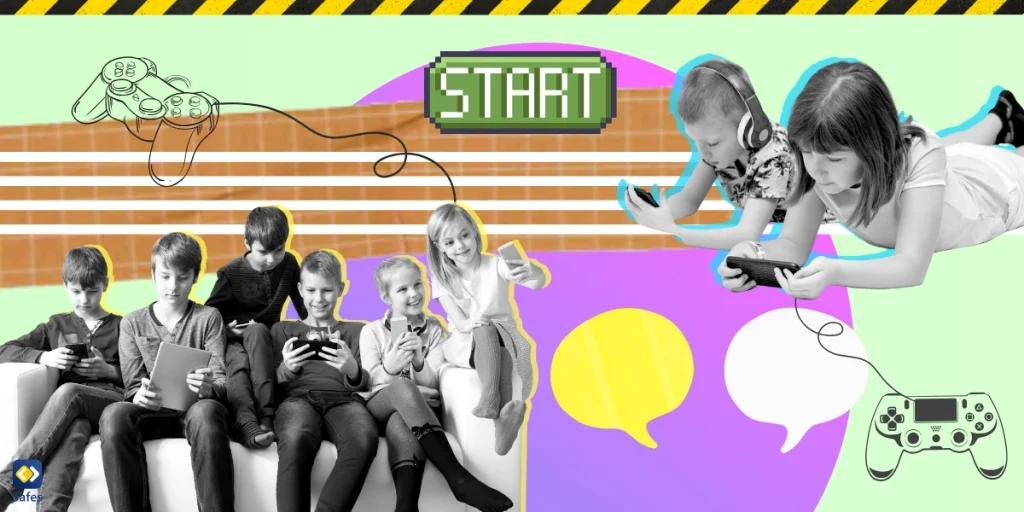As a parent, understanding the dangers of online chatting games is an important step in safeguarding your child as they navigate the digital world. Online gaming platforms, while offering an entertaining avenue for games to play online, can expose young gamers to risks like cyberbullying, identity theft, and encounters with online predators. From chat rooms for 10–13-year-olds to popular platforms hosting games like Fortnite and Minecraft, the virtual space is fraught with potential threats that can lurk in video game chat rooms and chat online with friends video interfaces.
Download and Start Your Free Trial of the Safes Parental Control App
Your awareness of these hazards is crucial, especially as online predators often masquerade as peers in safe chat rooms online, only to gather personal information with malicious intent. Moreover, your child’s clean credit record makes them an attractive target for identity theft, with criminals quick to utilize their untarnished personal details. Malware and phishing, too, are prevalent dangers, aiming to steal sensitive information or disrupt security through the seemingly innocent act of playing online games.
In this guide, you will gain comprehensive insights into the risks associated with online chatting games, strategies to help keep your children safe, and how to use parental control applications effectively. Prepare to equip yourself with knowledge and tools that will act as safeguards for your family’s digital experiences.
Understanding the Risks of Online Chatting Games
As children delve into the realm of online chatting games, it is essential to understand the myriad of risks they carry, many of which are not immediately apparent. Engaging in games to play online often means interacting with a global network of players, each with different intentions and backgrounds. Here are some critical dangers that every parent should be aware of:
Cyberbullying: In video game chat rooms, players can hide behind the anonymity of their screen names, leading to behavior that can cause significant psychological distress. It’s not uncommon for individuals to engage in harassment, use offensive language, and exhibit aggressive behavior, leaving a lasting impact on young players.
Privacy Risks: Chat rooms with games might seem harmless, but they can be gateways for gatherers of personally identifiable information. Personal details unwittingly shared during a casual game can pave the way for identity theft and phishing attacks, where con artists use the gathered information to trick you or your child into revealing more.
Malware and Security Threats: Be wary of third-party sellers and unofficial download sources, as these can be riddled with malware, spyware, and viruses. These malicious programs not only compromise the security of your device but open up a backdoor to your private information. Regular updates and robust antivirus software are paramount in keeping these at bay.
In the heat of gameplay and the camaraderie of chat online with friends video sessions, young gamers might overlook the odd behavior or manipulation from another player. Predators often lurk in safe chat rooms online, seeking to groom and lure unsuspecting victims into dangerous situations.

Most Popular Games Children Play while Chatting and their Risks
As your children immerse themselves in the digital playground of online chatting games, it’s essential to be cognizant of the platforms they frequent and the inherent dangers they may confront. Popular streaming services such as Twitch and Discord offer kids an engaging way to connect with friends and other gamers across the globe. However, these platforms also present varied communication options, including open chat rooms, private messaging, and video or voice chat capabilities, each with its own set of risks.
In open chat rooms, where everyone can participate and conversations are visible to all, the risk of exposure to bullying, inappropriate content, and potential grooming is heightened. Sadly, private chat rooms are not safer by default; these one-on-one interactions can become breeding grounds for manipulation, particularly by predators skilled in the art of deception. To complicate matters, platforms like Facebook Gaming entice with their accessibility and integration into social media, often blurring the lines between harmless play and harmful conversations.
Strategies for Keeping Children Safe
Considering the vast network of individuals your child might interact with in online chatting games, it’s imperative to apply strategies that ensure their safety. Understanding the risks is only part of the equation; active parental involvement in their digital lives is key to their protection. Here are some strategies you can employ:
Discuss and Understand Games: Dive into the virtual worlds your child visits. Get to know the games they play in online, familiarize yourself with the gameplay, and understand the chat features they use. Whether they’re in chat rooms for 10–13-year-olds or using platforms like Discord, having firsthand knowledge helps you guide them effectively.
Set Up Parental Controls: Take advantage of the parental control options available on popular gaming platforms. These controls can restrict game time, filter out inappropriate content, and monitor in-game purchases. You can adjust settings for:
- Game consoles like Nintendo Switch, PlayStation 4, and Xbox One
- PC gaming platforms such as EA/Origin and Steam
- Mobile games including Clash of Clans and Stardew Valley
Open Communication: Foster an environment where children feel comfortable discussing their online experiences and friends. Assure them that they can report suspicious behavior without fear of reprimand. Maintain a routine of regular conversations about the games they enjoy and the interactions they have.
In terms of practical steps, implementing these essential safety tips for playing video games can significantly reduce risks:
- Never share personal information with strangers in game chat rooms.
- Teach your child about the importance of reporting any troubling interactions they encounter.
- Keep a close watch on their friends’ list, ensuring they’re only connecting with known and trusted individuals.
To manage the online risks more effectively:
- Set rules and boundaries around online gaming activities, including time limits and designated usage times.
- Encourage your child to play online games with real-life friends rather than strangers.
- If ever worried about another player’s behavior, it’s crucial to tell a trusted adult. It’s also recommended to reach out to organizations such as Childline (0800 1111) or the Child Exploitation and Online Protection command (CEOP).
Educating yourself and your child about the darker aspects of online gaming is undoubtedly essential. Cyberbullying, online scams, and inappropriate content are relentless dangers. As a caring guide, providing insights into these risks equips your child with the awareness to make wise decisions online.
The ICAC Task Force Program, partnered with over 4500 enforcement agencies, underscores the gravity of online child victimization. Being proactive, managing risks, and ensuring your child is well-informed are your best defenses against these digital threats. Monitoring your child’s online activity with a watchful eye for grooming behaviors, setting stringent privacy settings, and having frank discussions about online safety are all central to keeping them out of harm’s way.
In the realm of online chatting games, vigilance and education are power. Harness these strategies, and you’ll create a more secure environment for your child to enjoy the benefits of digital gaming and social interaction while minimizing the potential risks they may encounter.

Safes Parental Control App
The digital landscape that online chatting games inhabit is vast and often unpredictable, teeming with opportunities for both fun and unforeseen risks. As we’ve navigated through the potential threats of cyberbullying, privacy breaches, and encounters with online predators, it becomes abundantly clear that parental vigilance and open communication are indispensable tools. By arming ourselves with the knowledge of these dangers and employing strategies to mitigate them—from robust parental controls to fostering an environment of trust and dialogue—we enhance the safety of our children’s online interactions and their overall digital well-being.
Thankfully there are many digital tools that parents can use to monitor and control their children’s online activities. One of these tools is the Safes parental control app. A very practical and user-friendly parental control app that offers many tools to parents, including receiving alerts anytime their children send or receive inappropriate or risky messages on messaging apps like WhatsApp.
Feel free to start your Safes free trial. You can download Safes from major app distribution platforms like Google Play and App Store.
Also, you might find the instructions below helpful. We’ve compiled comprehensive guides on setting up default parental controls across various devices. Whether your child is using Android, iPhone, Mac, or Windows, our step-by-step resources will enable you to create a safer digital environment for your family. Click on the links below to access tailored instructions for each device:
- Windows parental controls
- Macbook parental controls
- Android parental controls
- iPhone parental controls

Conclusion
As this comprehensive journey through the digital playlands of online chatting games concludes, it is our hope that you feel better equipped and more confident in guiding and protecting your child. Let’s reexamine the essential strategies and resources you have at your disposal to thwart cyber dangers:
Constant Vigilance: Continuously monitor your child’s online game usage and interactions. Awareness of who they’re communicating with and the content they’re exposed to is crucial in preventing exposure to online risks.
Open Dialogues: Cultivate an environment where conversations about the intricate landscape of online chatting games are routine. It’s these critical talks that will instill in your child the importance of digital caution and prudence.
Implementing Safety Measures: Something as simple as keeping personal information private can be a formidable barrier against cyber threats. Combine this with the use of savvy parental control apps, and you’ve greatly enhanced your child’s safety online.
Educate and Empower: Equip your children with the knowledge to identify and respond appropriately to cyberbullying, phishing attempts, and unsolicited advances by strangers within games to play in online.
With these pillars in place, your role in mitigating the perils of the virtual arena becomes significantly more effective. It’s not just about setting up barriers; it’s also about nurturing the understanding and critical thinking that your children need to navigate online chatting games safely.
To reiterate, the internet, for all its advantages, can be a perilous landscape for young, unsuspecting minds. By revisiting online chatting games’ potential risks, from chat video game chat rooms to chat rooms for 10–13-year-olds, you can reassess and fortify the safeguards necessary to shield your child.
Remember, it’s a collective endeavor involving parents, educators, and online platforms themselves to ensure safe chat rooms online. Hence, the dialogue about online chat safety must continue at home, in schools, and across all platforms where interaction is integral to the experience. Moreover, reach out to resources such as the Cybersmile gaming help center and Internet Matters with confidence.
The purpose of this guide was never just to alarm but to empower. It is in the robust exchange of informed dialogue and proactive strategies that our children can enjoy the richness of the digital world, anchored by the safety nets woven through your care and foresight. Let the insight you’ve gathered here on online chatting games lead you to be an unwavering guardian in the dynamic and ever-evolving realm of online play.
Your Child’s Online Safety Starts Here
Every parent today needs a solution to manage screen time and keep their child safe online.
Without the right tools, digital risks and excessive screen time can impact children's well-being. Safes helps parents set healthy boundaries, monitor activity, and protect kids from online dangers—all with an easy-to-use app.
Take control of your child’s digital world. Learn more about Safes or download the app to start your free trial today!




